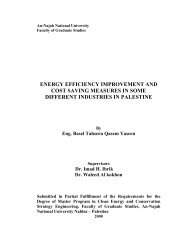THE GENUS PYTHIUM - An-Najah National University
THE GENUS PYTHIUM - An-Najah National University
THE GENUS PYTHIUM - An-Najah National University
Create successful ePaper yourself
Turn your PDF publications into a flip-book with our unique Google optimized e-Paper software.
Little is known about the distribution of population of Pythium species in soil<br />
either on a global or on a local basis, particularly in quantitative terms. The<br />
introduction of selective media has enabled estimates of propagule numbers to<br />
be made. Pvthium population under pine in Georgia (U.S.A.) were determined<br />
by Otrosina and Marx (1975) who found means for numbers of propagules from<br />
all sites to range from 0-5.2 propagules.g dry wt-I over all seasons; isolates<br />
corresponding to the Pythium irregulare-P. debaryanum complex were most<br />
frequently isolated. Lumsden et al. (1976) and Pieczarka & Abawi (1978) studied<br />
Pythium species population in bean fields in Maryland and New York<br />
respectiverly, and found Pythium isolates with spherical sporangia and which<br />
did not produce oogonia and P. uftimum to be most frequent.<br />
Pythium population in forest nursery soils in Australia and Canada and in the<br />
south eastern United States were studied by Vaartaja (1964,1968) and Hendrix<br />
& Campbell (1968) respectively. They found P. irregulare to be the most<br />
abundant species.<br />
The distribution of Pythium were studied by Hendrix & Campbell (1970) in<br />
different soils from many parts of the USA. Heterothallic forms together with<br />
isolates referable as P. irregulare- P. debaryanum complex, were found to<br />
dominate Pythium flora in the soils studied.<br />
Twenty eight to thirty five years ago,Remy (1950), Warcup (1952) and Barton<br />
(1958)all concluded that Pythium species were abundant in cultivated soils but<br />
infrequent in uncultivated, undisturbed soils. However their conclusions were<br />
based on recovery techniques which are known to be less satisfactory for<br />
quantitative studies, thus making direct comparisons of population levels<br />
impossible. Using a selective medium (VP3) and the surface-soil-dilution-plate<br />
procedure, Ali (1982), Ali-Shtayeh et af (l986a,b), Ali-Shtayeh & Dick (1986);<br />
and Dick & Ali-Shtayeh (1986) studied Pythium populations in a large number<br />
of cultivated and uncultivated soils in Britian and found Pythium species to be<br />
more abundant in cultivated farmland soils than in undisturbed, uncultivated<br />
parkland soils. Species widely distributed in uncultivated soils were P.<br />
sylvaticum, P. rostratum, P. parvum, and P. acanthicum .. The abundant and<br />
widespread species in cultivated farmland soils were P. minor, P. parvum, P.<br />
rostratum and P. vanrerpoolii.<br />
Pythium populations in a wide range of irrigated and nonirrigated fields in the<br />
West Bank and Gaza Strip have been studied by the author. A part of this work<br />
has now been published (Ali, 1985, Ali-Shtayeh, 1985,1986 a,b).<br />
In this monograph a guide to the isolation and identification of Pythium<br />
species is provided. Descriptions are also provided for 31 species. The remaining<br />
species isolated from the West Bank and Gaza Strip are outlined briefly. All the<br />
plants from which Pvthium species have been recovdred are listed.<br />
4





